Estimation of High-Resolution Soil Moisture in Canadian Croplands Using Deep Neural Network with Sentinel-1 and Sentinel-2 Images
Abstract
:1. Introduction
2. Data and Methods
2.1. Study Area and Observational Data
2.2. Satellite Datasets
2.3. Construction of a Comprehensive Dataset for Soil Moisture Modeling
2.4. DNN Modeling
3. Results and Discussion
3.1. Model Accuracy and Optimal Model
3.2. Soil Moisture Mapping at the Local Scale
4. Conclusions
Author Contributions
Funding
Conflicts of Interest
Abbreviations
| AAFC | Agriculture and Agri-Food Canada |
| AdaDelta | Adaptive Delta |
| CC | Correlation Coefficient |
| CD | Change Detection |
| CV | Cross-Validation |
| dB | Decibels |
| DAP | Departure from Average Precipitation |
| DEM | Digital Elevation Model |
| DNN | Deep Neural Network |
| DR | Dropout Ratio |
| ESA | European Space Agency |
| EVI | Enhanced Vegetation Index |
| GRD | Ground Range Detected |
| GRNN | Generalized Regression Neural Network |
| H | Hidden Layer |
| IEM | Integral Equation Model |
| IFOV | Instantaneous Field of View |
| IW | Interferometric Wide |
| LST | Land Surface Temperature |
| MAE | Mean Absolute Error |
| MBE | Mean Bias Error |
| ML | Machine Learning |
| MSI | Moisture Stress Index |
| NASA | National Aeronautics and Space Administration |
| NDMI | Normalized Differential Moisture Index |
| NDVI | Normalized Difference Vegetation Index |
| NDWI | Normalized Difference Water Index |
| NIR | Near-Infrared |
| NN | Neural Network |
| OLS | Ordinary Least Squares |
| ReLU | Rectified Linear Unit |
| RFR | Random Forest Regression |
| RISMA | Real-Time In Situ Soil Monitoring for Agriculture |
| RMI | Radar Moisture Index |
| RMSH | Root-Mean-Square Height |
| RMSE | Root-Mean-Square Error |
| ROI | Region of Interest |
| RTM | Radiative Transfer Model |
| S1 | Sentinel-1 |
| S2 | Sentinel-2 |
| SAR | Synthetic-Aperture Radar |
| SAVI | Soil-Adjusted Vegetation Index |
| SD | Standard Deviation |
| SM | Soil Moisture |
| SMAP | Soil Moisture Active Passive |
| SMOS | Soil Moisture and Ocean Salinity |
| SNAP | Sentinel Application Platform |
| SRTM | Shuttle Radar Topography Mission |
| SVM | Support Vector Machine |
| SVR | Support Vector Regression |
| SWIR | Shortwave Infrared |
| TDR | Time-Domain Reflectometry |
| TVDI | Temperature Vegetation Dryness Index |
| VI | Vegetation Index |
| VH | Vertical–Horizontal |
| VV | Vertical–Vertical |
| WCM | Water Cloud Model |
Appendix A

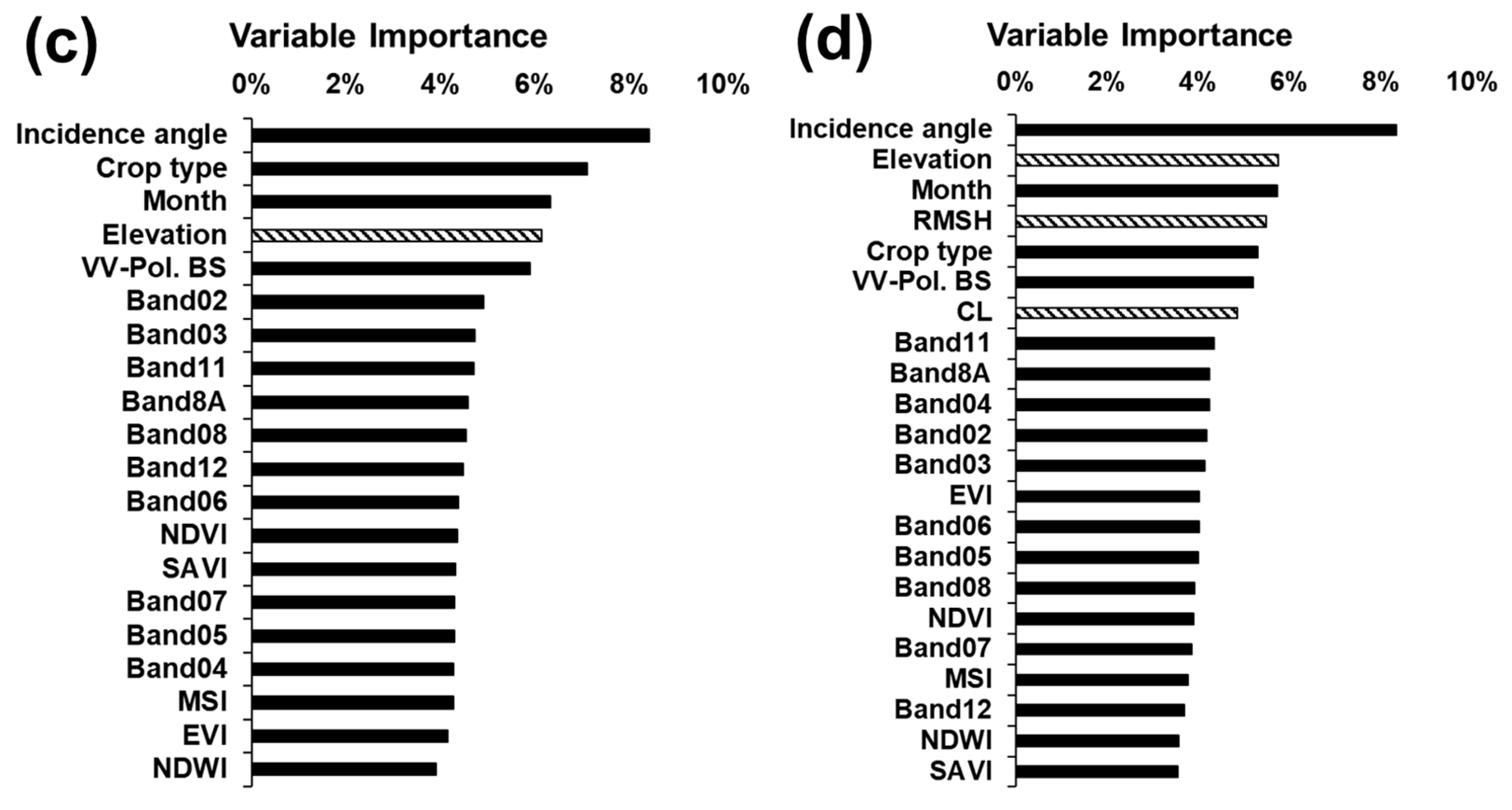
References
- Robock, A. HYDROLOGY|Soil Moisture. In Encyclopedia of Atmospheric Sciences; Academic Press: Cambridge, MA, USA, 2003; pp. 987–993. [Google Scholar]
- Engman, E.T. Soil Moisture: The Hydrologic Interface between Surface and Ground Waters; Laboratory for Hydrospheric Processes Research Publications: Greenbelt, MD, USA, 1997. [Google Scholar]
- Al-Yaari, A.; Wigneron, J.P.; Ducharne, A.; Kerr, Y.H.; Wagner, W.; De Lannoy, G.; Mialon, A. Global-Scale Comparison of Passive (SMOS) and Active (ASCAT) Satellite Based Microwave Soil Moisture Retrievals with Soil Moisture Simulations (MERRA-Land). Remote Sens. Environ. 2014, 152, 614–626. [Google Scholar]
- Arora, V.K.; Boer, G.J. The Temporal Variability of Soil Moisture and Surface Hydrological Quantities in a Climate Model. J. Clim. 2006, 19, 5875–5888. [Google Scholar] [CrossRef]
- Trugman, A.T.; Medvigy, D.; Mankin, J.S.; Anderegg, W.R.L. Soil Moisture Stress as a Major Driver of Carbon Cycle Uncertainty. Geophys. Res. Lett. 2018, 45, 6495–6503. [Google Scholar] [CrossRef]
- Verhoest, N.E.; Lievens, H.; Wagner, W.; Álvarez-Mozos, J.; Moran, M.S.; Mattia, F. On the Soil Roughness Parameterization Problem in Soil Moisture Retrieval of Bare Surfaces from Synthetic Aperture Radar. Sensors 2008, 8, 4213–4248. [Google Scholar]
- Seneviratne, S.I.; Corti, T.; Davin, E.L.; Hirschi, M.; Jaeger, E.B.; Lehner, I.; Orlowsky, B.; Teuling, A.J. Investigating Soil Moisture—Climate Interactions in a Changing Climate: A Review. Earth-Sci. Rev. 2010, 99, 125–161. [Google Scholar] [CrossRef]
- Caldwell, T.G.; Bongiovanni, T.; Cosh, M.H.; Halley, C.; Young, M.H. Field and Laboratory Evaluation of the CS655 Soil Water Content Sensor. Vadose Zone J. 2018, 17, 1–16. [Google Scholar] [CrossRef]
- Bittelli, M. Measuring Soil Water Content: A Review. HortTechnology 2011, 21, 293–300. [Google Scholar] [CrossRef]
- Lee, C.S.; Sohn, E.; Park, J.D.; Jang, J.D. Estimation of Soil Moisture Using Deep Learning Based on Satellite Data: A Case Study of South Korea. GISci. Remote Sens. 2019, 56, 43–67. [Google Scholar] [CrossRef]
- Neelam, M.; Mohanty, B.P. Global Sensitivity Analysis of the Radiative Transfer Model. Water Resour. Res. 2015, 51, 2428–2443. [Google Scholar] [CrossRef]
- Bhatta, B. Research Methods in Remote Sensing; SpringerBriefs in Earth Sciences; Springer: Dordrecht, The Netherlands, 2013. [Google Scholar]
- Sheffield, J.; Xia, Y.; Luo, L.; Wood, E.F.; Ek, M.; Mitchell, K.E. North American Land Data Assimilation System: A Framework for Merging Model and Satellite Data for Improved Drought Monitoring. Remote Sens. 2012, 4, 1902–1924. [Google Scholar]
- European Space Agency (ESA). Sentinel-2 MSI User Guide. Available online: https://sentinels.copernicus.eu/web/sentinel/user-guides/sentinel-2-msi (accessed on 1 May 2023).
- Das, K.; Paul, P.K. Present Status of Soil Moisture Estimation by Microwave Remote Sensing. Cogent Geosci. 2015, 1, 1084669. [Google Scholar] [CrossRef]
- Panciera, R.; Tanase, M.A.; Lowell, K.; Walker, J.P. Evaluation of IEM, Dubois, and Oh Radar Backscatter Models Using Airborne L-Band SAR. IEEE Trans. Geosci. Remote Sens. 2014, 52, 4966–4979. [Google Scholar] [CrossRef]
- Baghdadi, N.; Mehrez, Z. Evaluation of Radar Backscatter Models IEM, OH and Dubois Using Experimental Observations. Int. J. Remote Sens. 2006, 27, 3831–3852. [Google Scholar] [CrossRef]
- Merzouki, A.; McNairn, H. A Hybrid (Multi-Angle and Multipolarization) Approach to Soil Moisture Retrieval Using the Integral Equation Model: Preparing for the RADARSAT Constellation Mission. Can. J. Remote Sens. 2015, 41, 349–362. [Google Scholar] [CrossRef]
- Oh, Y.; Sarabandi, K.; Ulaby, F.T. Semi-empirical model of the ensemble-averaged differential Mueller matrix for microwave backscattering from bare soil surfaces. IEEE Trans. Geosci. Remote Sens. 2002, 40, 1348–1355. [Google Scholar] [CrossRef]
- Dubois, P.C.; van Zyl, J.; Engman, T. Measuring soil moisture with imaging radars. IEEE Trans. Geosci. Remote Sens. 1995, 33, 915–926. [Google Scholar] [CrossRef]
- Shoshany, M.; Svoray, T.; Curran, P.; Foody, G.M.; Perevolotsky, A. The Relationship between ERS-2 SAR Backscatter and Soil Moisture: Generalization from a Humid to Semi-arid Transect. Int. J. Remote Sens. 2000, 21, 2337–2343. [Google Scholar] [CrossRef]
- Baghdadi, N.; Cerdan, O.; Zribi, M.; Auzet, V.; Darboux, F.; El Hajj, M.; Kheir, R.B. Operational Performance of Current Synthetic Aperture Radar Sensors in Mapping Soil Surface Characteristics in Agricultural Environments: Application to Hydrological and Erosion Modelling. Hydrol. Process. Int. J. 2007, 22, 9–20. [Google Scholar] [CrossRef]
- Kim, Y.H.; Hong, S.Y.; Lee, J.E. Estimation of Soil Moisture Content from Backscattering Coefficients Using a Radar Scatterometer. Korean J. Soil Sci. Fertil. 2012, 45, 127–134. [Google Scholar] [CrossRef]
- Dobson, M.C.; Ulaby, F.T.; Hallikainen, M.T.; El-Rayes, M.A. Microwave Dielectric Behavior of Wet Soil-Part II: Dielectric Mixing Models. IEEE Trans. Geosci. Remote Sens. 1985, GE-23, 35–46. [Google Scholar] [CrossRef]
- Sandholt, I.; Rasmussen, K.; Andersen, J. A Simple Interpretation of the Surface Temperature/Vegetation Index Space for Assessment of Surface Moisture Status. Remote Sens. Environ. 2002, 79, 213–224. [Google Scholar] [CrossRef]
- Zhang, F.; Zhang, L.W.; Shi, J.J.; Huang, J.F. Soil Moisture Monitoring Based on Land Surface Temperature-Vegetation Index Space Derived from MODIS Data. Pedosphere 2014, 24, 450–460. [Google Scholar] [CrossRef]
- Gao, Q.; Zribi, M.; Escorihuela, M.; Baghdadi, N. Synergetic Use of Sentinel-1 and Sentinel-2 Data for Soil Moisture Mapping at 100 m Resolution. Sensors 2017, 17, 1966. [Google Scholar] [CrossRef] [PubMed]
- Bousbih, S.; Zribi, M.; El Hajj, M.; Baghdadi, N.; Lili-Chabaane, Z.; Gao, Q.; Fanise, P. Soil Moisture and Irrigation Mapping in A Semi-Arid Region, Based on the Synergetic Use of Sentinel-1 and Sentinel-2 Data. Remote Sens. 2018, 10, 1953. [Google Scholar] [CrossRef]
- Tripathi, A.; Tiwari, R.K. Synergetic Utilization of Sentinel-1 SAR and Sentinel-2 Optical Remote Sensing Data for Surface Soil Moisture Estimation for Rupnagar, Punjab, India. Geocarto Int. 2020, 37, 2215–2236. [Google Scholar] [CrossRef]
- Attarzadeh, R.; Amini, J.; Notarnicola, C.; Greifeneder, F. Synergetic Use of Sentinel-1 and Sentinel-2 Data for Soil Moisture Mapping at Plot Scale. Remote Sens. 2018, 10, 1285. [Google Scholar] [CrossRef]
- Liu, Y.; Qian, J.; Yue, H. Combined Sentinel-1A with Sentinel-2A to Estimate Soil Moisture in Farmland. IEEE J. Sel. Top. Appl. Earth Obs. Remote Sens. 2021, 14, 1292–1310. [Google Scholar] [CrossRef]
- Santurkar, S.; Tsipras, D.; Ilyas, A.; Madry, A. How does batch normalization help optimization? In Advances in Neural Information Processing Systems; Bengio, S., Wallach, H., Larochelle, H., Grauman, K., Cesa-Bianchi, N., Garnett, R., Eds.; NeurIPS: Montréal, QC, Canada, 2018; pp. 2483–2493. [Google Scholar]
- Li, Z.; Gong, B.; Yang, T. Improved dropout for shallow and deep learning. In Proceedings of the Advances in Neural Information Processing Systems, Barcelona, Spain, 9 December 2016; pp. 2523–2531. [Google Scholar]
- Goodfellow, I.; Bengio, Y.; Courville, A.; Bengio, Y. Deep Learning; MIT Press: Cambridge, UK, 2016. [Google Scholar]
- Zhang, W.; Du, T.; Wang, J. Deep Learning over Multi-field Categorical Data. In Advances in Information Retrieval, Proceedings of the 38th European Conference on IR Research, ECIR 2016, Padua, Italy, 20–23 March 2016; Springer: Berlin/Heidelberg, Germany, 2016. [Google Scholar]
- Moradi, R.; Berangi, R.; Minaei, B. A Survey of Regularization Strategies for Deep Models. Artif. Intell. Rev. 2019, 53, 3947–3986. [Google Scholar] [CrossRef]
- Zhang, D.; Zhang, W.; Huang, W.; Hong, Z.; Meng, L. Upscaling of Surface Soil Moisture Using a Deep Learning Model with VIIRS RDR. ISPRS Int. J. Geo-Inf. 2017, 6, 130. [Google Scholar] [CrossRef]
- Government of Canada. Canadian Climate Normals. Available online: https://climate.weather.gc.ca/climate_normals/index_e.html (accessed on 1 May 2023).
- Pacheco, A.; L’Heureux, J.; McNairn, H.; Powers, J.; Howard, A.; Geng, X.; Rollin, P.; Gottfried, K.; Freeman, J.; Ojo, R.; et al. Real-Time In-Situ Soil Monitoring for Agriculture (RISMA) Network Metadata; Science and Technology Branch Agriculture and Agri-Food Canada: Edmonton, AB, Canada, 2014. [Google Scholar]
- El Hajj, M.; Baghdadi, N.; Bazzi, H.; Zribi, M. Penetration Analysis of SAR Signals in the C and L Bands for Wheat, Maize, and Grasslands. Remote Sens. 2019, 11, 31. [Google Scholar] [CrossRef]
- Ojo, E.R.; Bullock, P.R.; L’Heureux, J.; Powers, J.; McNairn, H.; Pacheco, A. Calibration and evaluation of a frequency domain reflectometry sensor for real-time soil moisture monitoring. Vadose Zone J. 2015, 14, 1–12. [Google Scholar] [CrossRef]
- Beale, J.; Snapir, B.; Waine, T.; Evans, J.; Corstanje, R. The Significance of Soil Properties to the Estimation of Soil Moisture from C-Band Synthetic Aperture Radar. Hydrol. Earth Syst. Sci. Discuss. 2019, 1–28. [Google Scholar] [CrossRef]
- Rycroft, D.W.; Amer, M.H. Prospects for the Drainage of the Clay Soils; Irrigation and Drainage Paper 51; FAO: Rome, Italy, 1995; p. 136. [Google Scholar]
- Wang, P.; Zhang, H.; Patel, V.M. SAR Image Despeckling Using a Convolutional Neural Network. IEEE Signal Process. Lett. 2017, 24, 1763–1767. [Google Scholar] [CrossRef]
- Shahrezaei, I.H.; Kim, H.C. Resolutional Analysis of Multiplicative High-Frequency Speckle Noise Based on SAR Spatial De-Speckling Filter Implementation and Selection. Remote Sens. 2019, 11, 1041. [Google Scholar] [CrossRef]
- Lee, S.-J.; Hong, S.; Cho, J.; Lee, Y.W. Experimental Retrieval of Soil Moisture for Cropland in South Korea Using Sentinel-1 SAR Data. Korean J. Remote Sens. 2017, 33, 947–960. [Google Scholar]
- Baghdadi, N.; Aubert, M.; Cerdan, O.; Franchistéguy, L.; Viel, C.; Martin, E.; Zribi, M.; Desprats, J.F. Operational Mapping of Soil Moisture Using Synthetic Aperture Radar Data: Application to Touch Basin (France). Sens. J. 2007, 7, 2458–2483. [Google Scholar] [CrossRef]
- Gandhi, G.M.; Parthiban, S.; Thummalu, N.; Christy, A. Ndvi: Vegetation Change Detection Using Remote Sensing and Gis—A Case Study of Vellore District. Procedia Comput. Sci. 2015, 57, 1199–1210. [Google Scholar] [CrossRef]
- Huete, A.; Didan, K.; Miura, T.; Rodriguez, E.P.; Gao, X.; Ferreira, L.G. Overview of the Radiometric and Biophysical Performance of the MODIS Vegetation Indices. Remote Sens. Environ. 2002, 83, 195–213. [Google Scholar] [CrossRef]
- Huete, A.R. A Soil-Adjusted Vegetation Index (SAVI). Remote Sens. Environ. 1988, 25, 295–309. [Google Scholar] [CrossRef]
- Cruz-Sanabria, H.; Sánchez, M.G.; Rivera-Caicedo, J.P.; Avila-George, H. Identification of phenological stages of sugarcane cultivation using Sentinel-2 images. In Proceedings of the 2020 9th International Conference on Software Process Improvement (CIMPS), Mazatlan, Sinaloa, Mexico, 21–23 October 2020; pp. 110–116. [Google Scholar]
- Hunt, E.R., Jr.; Rock, B.N. Detection of Changes in Leaf Water Content Using Near-and Middle-Infrared Reflectances. Remote Sens. Environ. 1989, 30, 43–54. [Google Scholar]
- Feng, H.; Chen, C.; Dong, H.; Wang, J.; Meng, Q. Modified Shortwave Infrared Perpendicular Water Stress Index: A Farmland Water Stress Monitoring Method. J. Appl. Meteorol. Climatol. 2013, 52, 2024–2032. [Google Scholar] [CrossRef]
- Ceccato, P.; Flasse, S.; Tarantola, S.; Jacquemoud, S.; Grégoire, J.-M. Detecting Vegetation Leaf Water Content Using Reflectance in the Optical Domain. Remote Sens. Environ. 2001, 77, 22–33. [Google Scholar] [CrossRef]
- Gao, B.C. NDWI-A Normalized Difference Water Index for Remote Sensing of Vegetation Liquid Water from Space. Remote Sens. Environ. 1996, 58, 257–266. [Google Scholar] [CrossRef]
- Holah, H.; Baghdadi, N.; Zribi, M.; Bruand, A.; King, C. Potential of ASAR/ENVISAT for the Characterisation of Soil Surface Parameters over Bare Agricultural Fields. Remote Sens. Environ. 2005, 96, 78–86. [Google Scholar] [CrossRef]
- National Aeronautics and Space Administration (NASA). Soil Moisture Dirt to Dinner. Available online: https://smap.jpl.nasa.gov/system/internal_resources/details/original/250_Soil_Moisture_Dirt_to_Dinner_3.5.14.pdf (accessed on 2 April 2023).
- Zhu, H.D.; Shi, Z.H.; Fang, N.F.; Wu, G.L.; Guo, Z.L.; Zhang, Y. Soil Moisture Response to Environmental Factors Following Precipitation Events in a Small Catchment. Catena 2014, 120, 73–80. [Google Scholar] [CrossRef]
- Li, J.; Wang, S. Using SAR-Derived Vegetation Descriptors in a Water Cloud Model to Improve Soil Moisture Retrieval. Remote Sens. 2018, 10, 1370. [Google Scholar] [CrossRef]
- Jensen, J.R. Introductory Digital Image Processing: A Remote Sensing Perspective, 4th ed.; Prentice Hall: Upper Saddle River, NJ, USA, 2015. [Google Scholar]
- Frampton, W.J.; Dash, J.; Watmough, G.; Milton, E.G. Evaluating the Capabilities of Sentinel-2 for Quantitative Estimation of Biophysical Variables in Vegetation. J. Photogramm. Remote Sens. 2013, 82, 83–92. [Google Scholar] [CrossRef]
- Kim, D.M.; Zhang, H.; Zhou, H.; Du, T.; Wu, Q.; Mockler, T.C.; Berezin, M.Y. Highly Sensitive Image-Derived Indices of Water-Stressed Plants Using Hyperspectral Imaging in SWIR and Histogram Analysis. Sci. Rep. 2015, 5, 15919. [Google Scholar] [CrossRef]
- Said, S.; Kothyari, U.C.; Arora, M.K. Vegetation Effects on Soil Moisture Estimation from ERS-2 SAR Images. Hydrol. Sci. J. 2012, 57, 517–534. [Google Scholar] [CrossRef]
- Jia, M.Q.; Tong, L.; Zhang, Y.Z.; Chen, Y. Multitemporal Radar Backscattering Measurement of Wheat Fields Using Multifrequency (L, S, C, and X) and Full-Polarization. Radio Sci. 2013, 48, 471–481. [Google Scholar] [CrossRef]
- Kaur, P.; Bala, A.; Singh, H.; Sandhu, S.S. Guidelines to Prepare Crop Weather Calendar; AICRPAM, School of Climate Change and Agricultural Meteorology, PAU: Ludhiana, India, 2013; p. 18. [Google Scholar]
- Tan, H.H.; Lim, K.H. Vanishing Gradient Mitigation with Deep Learning Neural Network Optimization. In Proceedings of the 7th International Conference on Smart Computing & Communications (ICSCC), Sarawak, Malaysia, 28–30 June 2019; pp. 1–4. [Google Scholar]
- Srivastava, N.; Hinton, G.; Krizhevsky, A.; Sutskever, I.; Salakhutdinov, R. Dropout: A Simple Way to Prevent Neural Networks from Overfitting. J. Mach. Learn. Res. 2014, 15, 1929–1958. [Google Scholar]
- Ying, X. An Overview of Overfitting and its Solutions. J. Phys. Conf. Ser. 2019, 1168, 022022. [Google Scholar] [CrossRef]
- Yaqub, M.; Feng, J.; Zia, M.; Arshid, K.; Jia, K.; Rehman, Z.; Mehmood, A. State-of-the-Art CNN Optimizer for Brain Tumor Segmentation in Magnetic Resonance Images. Brain Sci. 2020, 10, 427. [Google Scholar] [CrossRef] [PubMed]
- Greenwell, B.M.; Boehmke, B.C.; McCarthy, A.J. A Simple and Effective Model-Based Variable Importance Measure. arXiv 2018, arXiv:1805.04755. [Google Scholar]
- Candel, A.; Parmar, V.; LeDell, E.; Arora, A. Deep Learning with H2O; H2O. ai Inc.: Mountain View, CA, USA, 2016. [Google Scholar]
- Zobeck, T.M.; Onstad, C.A. Tillage and rainfall effects on random roughness: A review. Soil Tillage Res. 1987, 9, 1–20. [Google Scholar] [CrossRef]
- Collingwood, A.; Shang, C.; Charbonneau, F.; Treitz, P. Spatiotemporal Variability of Arctic Soil Moisture Detected from High-Resolution RADARSAT-2 SAR Data. Adv. Meteorol. 2018, 2018, 1–17. [Google Scholar] [CrossRef]
- Hobbs, S.; Ang, W.; Seynat, C. Wind and Rain Effects on SAR Backscatter from Crops. In Proceedings of the 2nd International Workshop on Retrieval of Bio- and Geophysical Parameters from SAR Data for Land Applications, ETEC, Noordwijk, The Netherlands, 21–23 October 1998. [Google Scholar]
- Wang, R.; Cherkauer, K.; Bowling, L. Corn Response to Climate Stress Detected with Satellite-Based NDVI Time Series. Remote Sens. 2016, 8, 269. [Google Scholar] [CrossRef]
- Eslamian, S.; Khordadi, M.J.; Abedi-Koupai, J. Effects of Variations in Climatic Parameters on Evapotranspiration in the Arid and Semi-Arid Regions. Glob. Planet. Chang. 2011, 78, 188–194. [Google Scholar] [CrossRef]
- Government of Canada. Departure from Average Precipitation (mm). Available online: https://open.canada.ca/data/en/dataset/7b817d93-f34d-4aa8-8658-d9abe9d84a8f (accessed on 15 May 2023).
- Bhuiyan, H.A.K.M.; McNairn, H.; Powers, J.; Merzouki, A. Application of HEC-HMS in a Cold Region Watershed and Use of RADARSAT-2 Soil Moisture in Initializing the Model. Hydrology 2017, 4, 9. [Google Scholar] [CrossRef]
- Manitoba Agriculture. AgriMaps. Available online: https://agrimaps.gov.mb.ca/agrimaps/# (accessed on 2 April 2023).
- Hu, X.T.; Chen, H.; Wang, J.; Meng, X.B.; Chen, F.H. Effects of Soil Water Content on Cotton Root Growth and Distribution under Mulched Drip Irrigation. Agric. Sci. China 2009, 8, 709–716. [Google Scholar] [CrossRef]
- Brocca, L.; Tarpanelli, A.; Filippucci, P.; Dorigo, W.; Zaussinger, F.; Gruber, A.; Fernández-Prieto, D. How Much Water Is Used for Irrigation? A New Approach Exploiting Coarse Resolution Satellite Soil Moisture Products. Int. J. Appl. Earth Obs. Geoinf. 2018, 73C, 752–766. [Google Scholar] [CrossRef]
- Kelly, T.; Foster, T.; Schultz, D.M.; Mieno, T. The Effect of Soil-Moisture Uncertainty on Irrigation Water Use and Farm Profits. Adv. Water Resour. 2021, 154, 103982. [Google Scholar] [CrossRef]
- Gao, X.; Shaw, W.S.; Tenuta, M.; Gibson, D. Yield and nitrogen use of irrigated processing potato in response to placement, timing and source of nitrogen fertilizer in Manitoba. Am. J. Potatato Res. 2018, 95, 513–525. [Google Scholar] [CrossRef]
- Chen, L.; Dirmeyer, P.A. Global observed and modelled impacts of irrigation on surface temperature. Int. J. Climatol. 2019, 39, 2587–2600. [Google Scholar] [CrossRef]
- Scherer, T.F.; Franzen, D.; Cihacek, L. AE1675 (Revised) Soil, Water and Plant Characteristics Important to Irrigation; NDSU Extension Service; North Dakota State University: Fargo, ND, USA, 2013; Available online: https://www.researchgate.net/profile/Larry-Cihacek/publication/281845779_Soil_water_and_plant_characteristics_important_to_irrigation/links/55fb01d208aec948c4afa85d/Soil-water-and-plant-characteristics-important-to-irrigation.pdf (accessed on 10 August 2023).
- Ren, F.; Yang, G.; Li, W.; He, X.; Gao, Y.; Tian, L.; Li, F.; Wang, Z.; Liu, S. Yield-compatible salinity level for growing cotton (Gossypium hirsutum L.) under mulched drip irrigation using saline water. Agric. Water Manag. 2021, 250, 106859. [Google Scholar] [CrossRef]
- Yang, G.; Li, F.; Tian, L.; He, X.; Gao, Y.; Wang, Z.; Ren, F. Soil Physicochemical Properties and Cotton (Gossypium hirsutum L.) Yield under Brackish Water Mulched Drip Irrigation. Soil Tillage Res. 2020, 199, 104592. [Google Scholar] [CrossRef]
- Wu, L.Y.; Feng, J.M.; Miao, W.H. Simulating the Impacts of Irrigation and Dynamic Vegetation over the North China Plain on Regional Climate. J. Geophys. Res. Atmos. 2018, 123, 8017–8034. [Google Scholar] [CrossRef]
- Zhu, P.; Burney, J. Untangling Irrigation Effects on Maize Water and Heat Stress Alleviation Using Satellite Data. Hydrol. Earth Syst. Sci. 2022, 26, 827–840. [Google Scholar] [CrossRef]
- Haghnazari, F.; Shahgholi, H.; Feizi, M. Factors Affecting the Infiltration of Agricultural Soils. Int. J. Agron. Agric. Res. 2015, 6, 21–35. [Google Scholar]
- Sharma, V. Methods and techniques for soil moisture monitoring. In Irrigation Management: Basics of Soil Water Bulletin. B-1331; University of Wyoming: Laramie, WY, USA, 2018; pp. 1–18. Available online: http://wyoextension.org/publications/html/B1331 (accessed on 10 August 2023).
- Trout, T.J. Furrow Irrigation Erosion and Sedimentation: On-field Distribution. Trans. ASAE 1996, 39, 1717–1723. [Google Scholar] [CrossRef]
- Zheng, Z.C.; He, S.Q.; Wu, F.Q. Changes of Soil Surface Roughness under Water Erosion Process. Hydrol. Process. 2014, 28, 3919–3929. [Google Scholar] [CrossRef]
- Wisser, D.; Frolking, S.; Douglas, E.M.; Fekete, B.M.; Vörösmarty, C.J.; Schumann, A.H. Global irrigation water demand: Variability and uncertainties arising from agricultural and climate data sets. Geophys. Res. Lett. 2008, 35, L24408. [Google Scholar] [CrossRef]
- Fan, L. Comparisons of Five Indices for Estimating Local Terrain Surface Roughness using LiDAR Point Clouds. In Proceedings of the 2022 29th International Conference on Geoinformatics (IEEE), Beijing, China, 15–18 August 2022; pp. 1–6. [Google Scholar]
- Ulaby, F.T.; Moore, R.K.; Fung, A.K. Microwave Remote Sensing: Active and Passive; Addison-Wesley: Reading, MA, USA, 1982; Volume II. [Google Scholar]
- Martinez-Agirre, A.; Álvarez-Mozos, J.; Milenković, M.; Pfeifer, N.; Giménez, R.; Valle, J.M.; Rodríguez, Á. Evaluation of Terrestrial Laser Scanner and Structure from Motion photogrammetry techniques for quantifying soil surface roughness parameters over agricultural soils. Earth Surf. Process. Landf. 2020, 45, 605–621. [Google Scholar] [CrossRef]
- Smith, A.C.; Zarnetske, P.; Dahlin, K.; Wilson, A.; Latimer, A. Package ‘geodiv’—Methods for Calculating Gradient Surface Metrics. Available online: https://cran.r-project.org/web/packages/geodiv/geodiv.pdf (accessed on 22 July 2023).




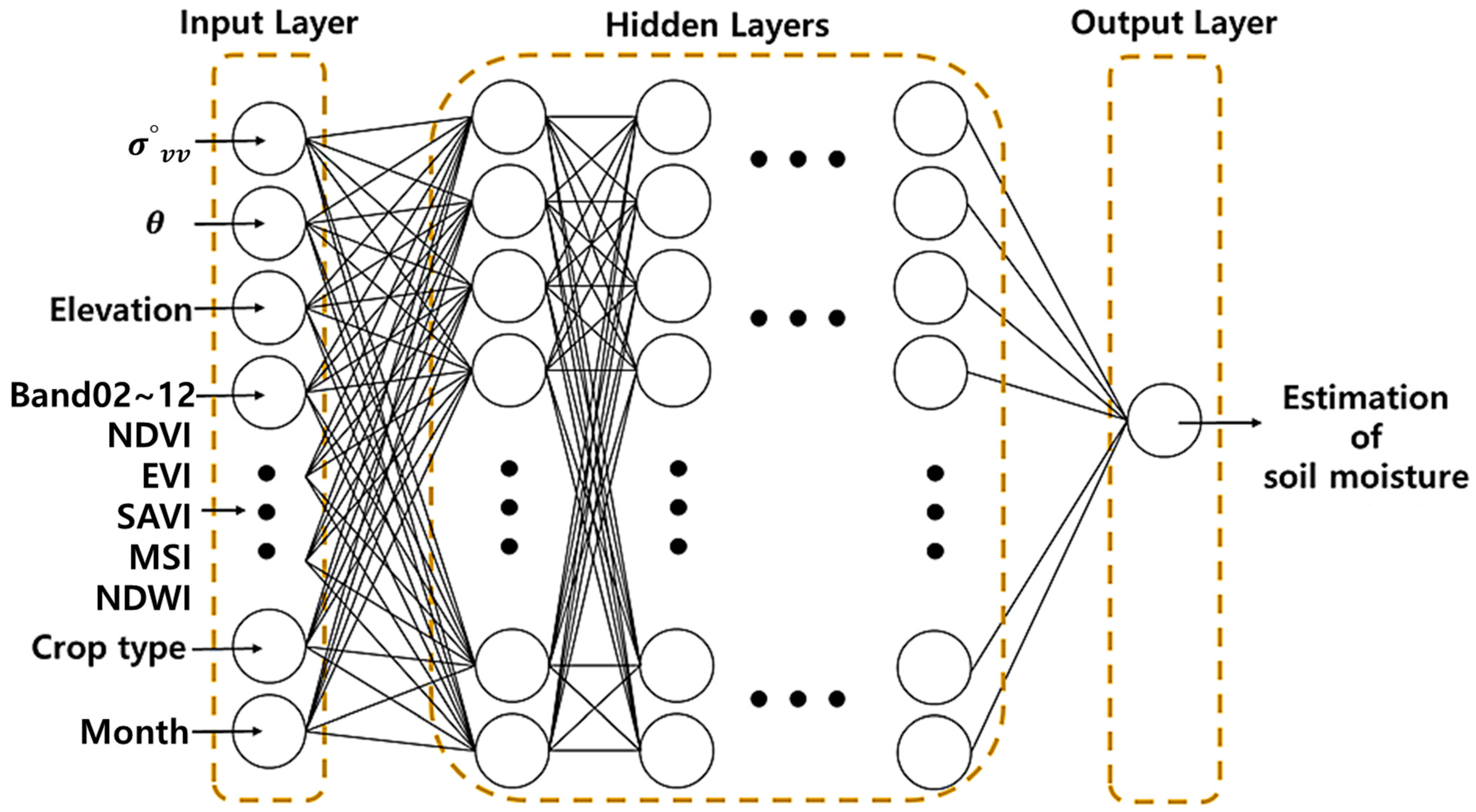

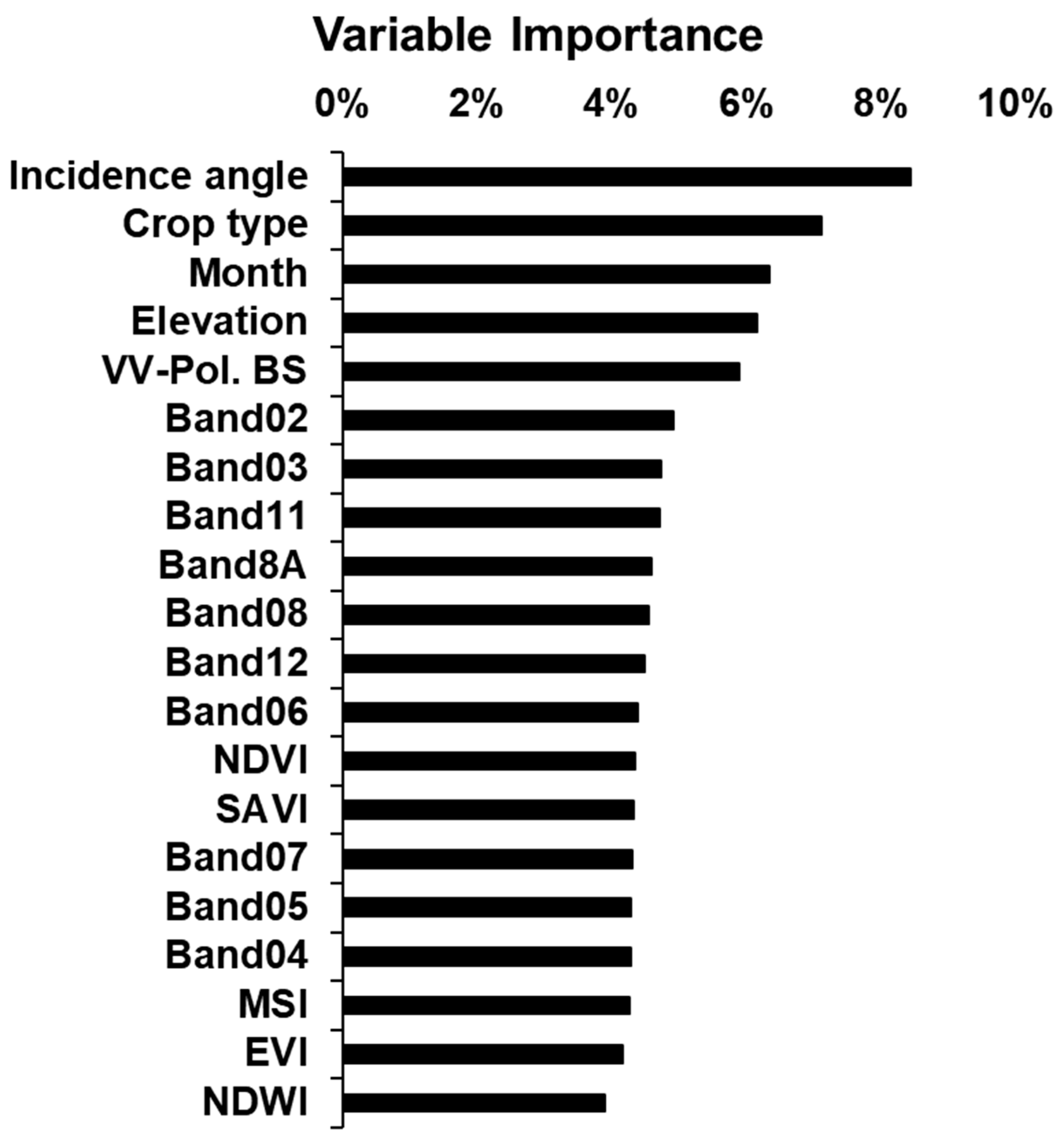
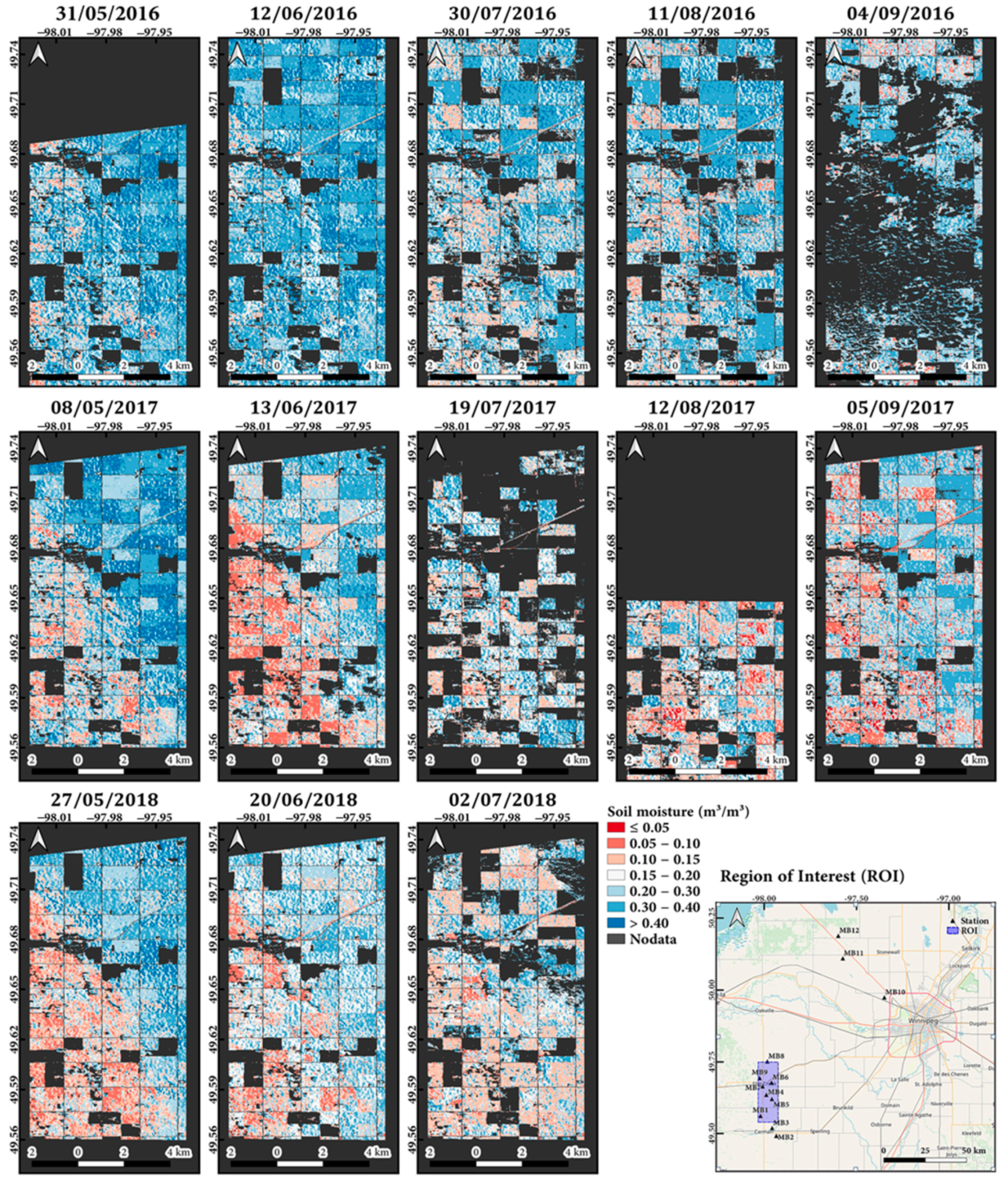

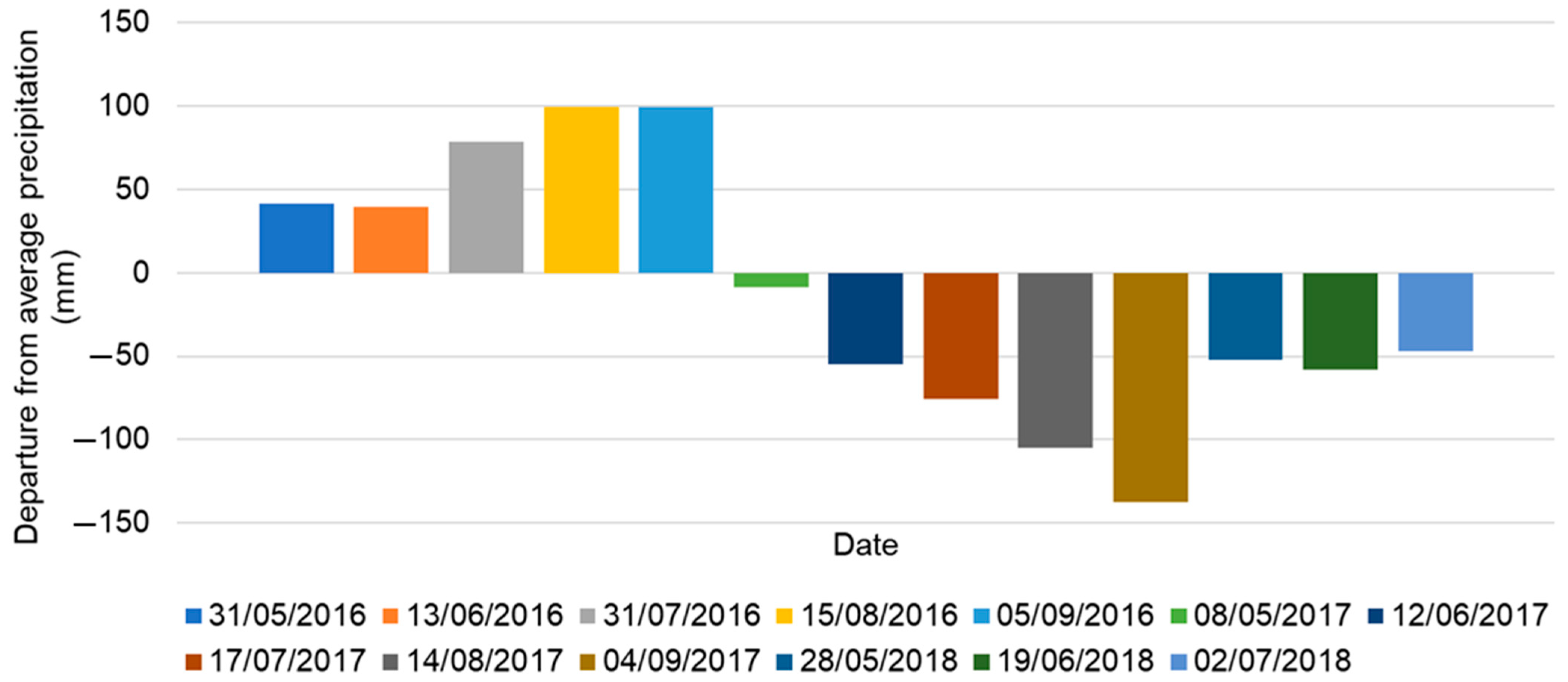
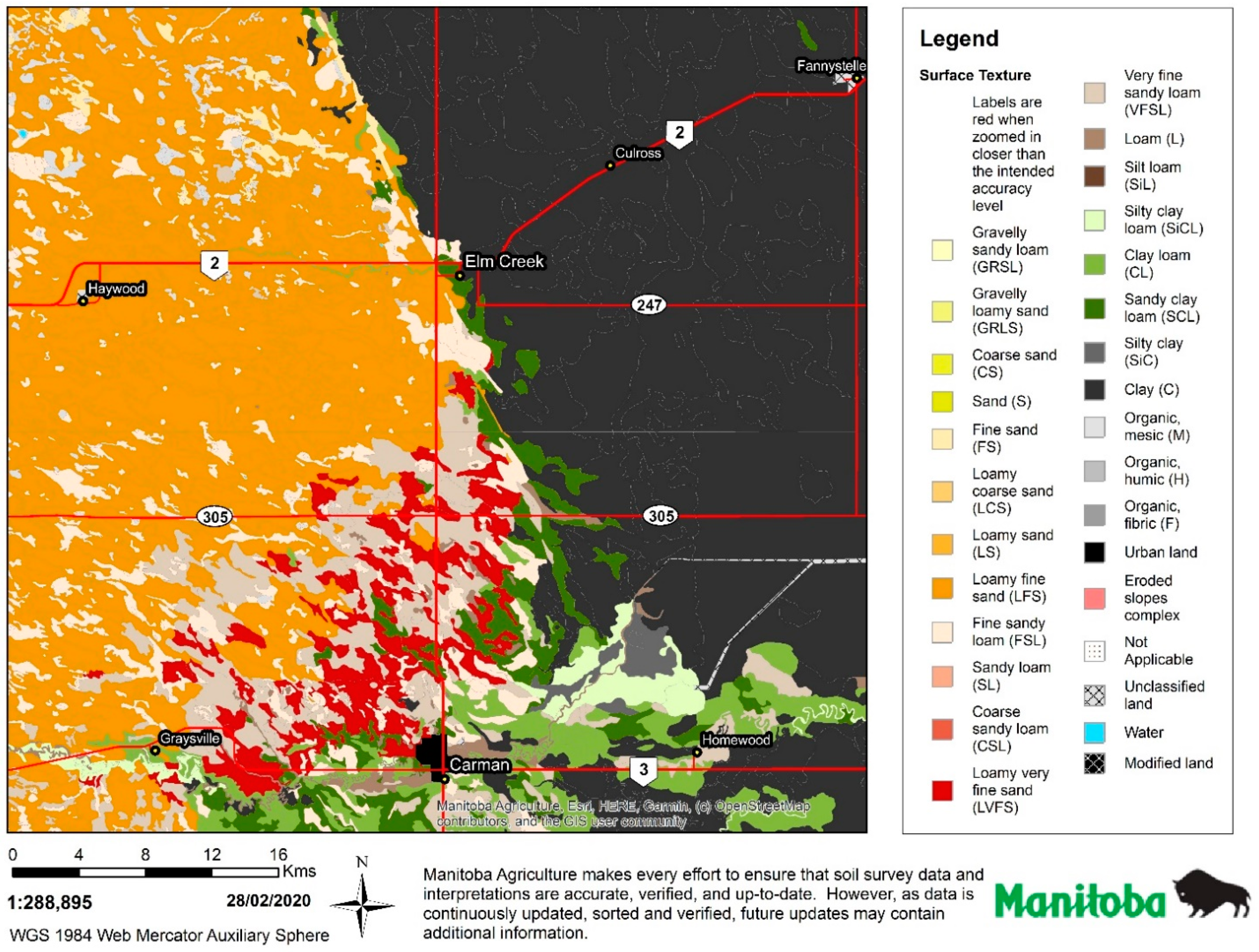
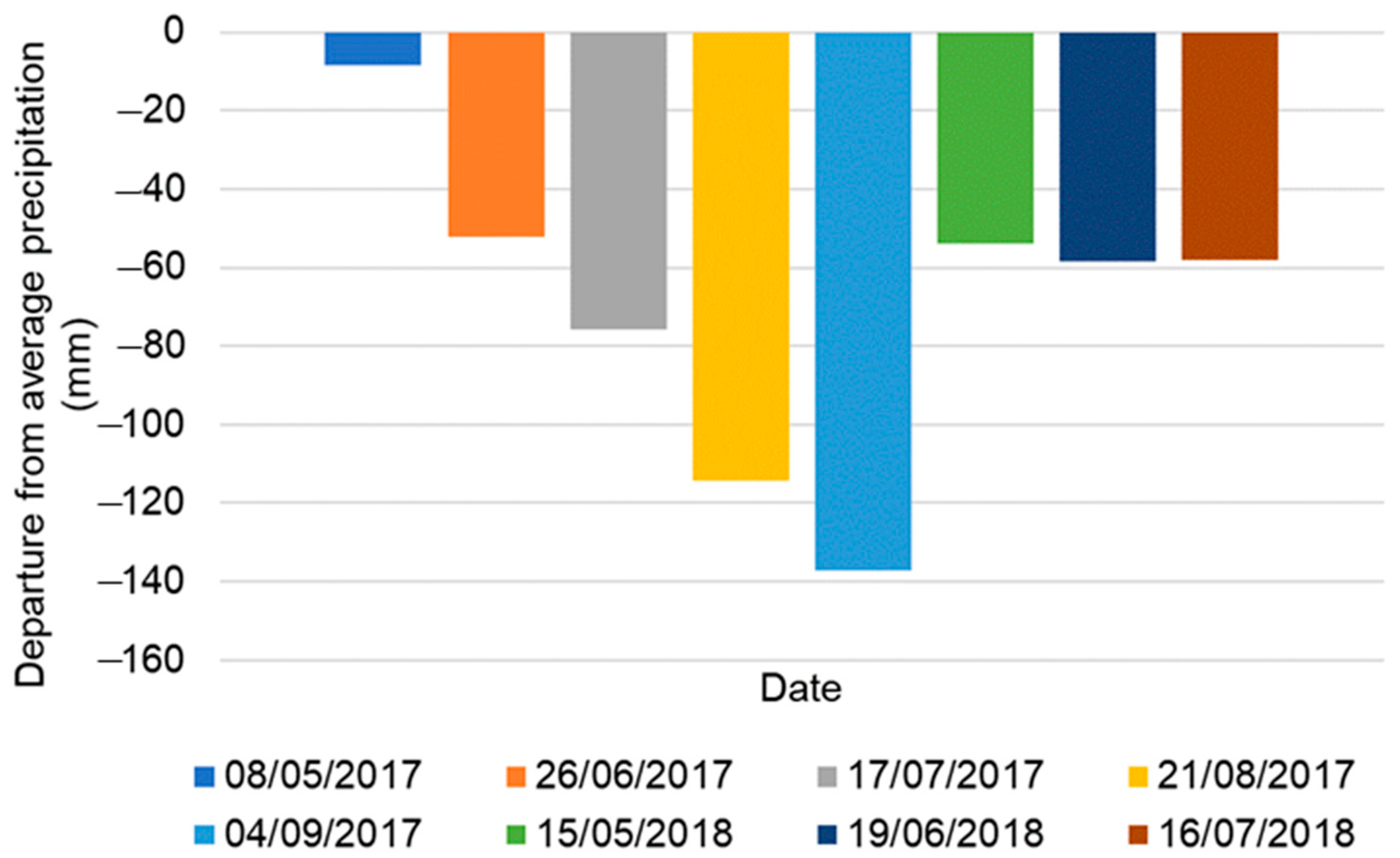
| Satellite | Bands | Frequency/Wavelength Characteristics | Resolution (m) |
|---|---|---|---|
| Sentinel-1 | VV | C-band (5.404 GHz) | 10 |
| VH | C-band (5.404 GHz) | 10 | |
| Sentinel-2 | Band1 (Coastal aerosol) | 0.443 μm | 60 |
| Band2 (Blue) | 0.490 μm | 10 | |
| Band3 (Green) | 0.560 μm | 10 | |
| Band4 (Red) | 0.665 μm | 10 | |
| Band5 (Red Edge) | 0.705 μm | 20 | |
| Band6 (Red Edge) | 0.740 μm | 20 | |
| Band7 (Red Edge) | 0.783 μm | 20 | |
| Band8 (NIR) | 0.842 μm | 10 | |
| Band8A (Narrow NIR) | 0.865 μm | 20 | |
| Band9 (Water vapor) | 0.945 μm | 60 | |
| Band10 (SWIR–Cirrus) | 1.375 μm | 60 | |
| Band11 (SWIR) | 1.610 μm | 20 | |
| Band12 (SWIR) | 2.190 μm | 20 |
| Station | Latitude | Longitude | Soil Texture | AAFC 2016 Crop Map |
|---|---|---|---|---|
| MB1 | 49.56234 | −98.01924 | Sandy Loam | Soybeans |
| MB2 | 49.4925 | −97.93374 | Clay Loam | Spring Wheat |
| MB3 | 49.51951 | −97.95649 | Sandy Clay Loam | Urban and Developed |
| MB4 | 49.63609 | −97.98813 | Sand | Spring Wheat |
| MB5 | 49.62145 | −97.95781 | Clay | Soybeans |
| MB6 | 49.67877 | −97.95957 | Heavy Clay | Spring Wheat |
| MB7 | 49.66552 | −98.00762 | Sandy Loam | Corn |
| MB8 | 49.75253 | −97.98237 | Heavy Clay | Urban and Developed |
| MB9 | 49.69462 | −98.02397 | Sandy Loam | Soybeans |
| MB10 | 49.97536 | −97.34829 | Heavy Clay | Sunflower |
| MB11 | 50.11131 | −97.57337 | Clay Loam | Barley |
| MB12 | 50.18998 | −97.59801 | Loam | Canola and Rapeseed |
| SK1 | 51.33484 | −106.56494 | Silty Clay Loam | Spring Wheat |
| SK2 | 51.33504 | −106.56389 | Silt Loam | Grassland |
| SK3 | 51.38415 | −106.46923 | Loam | Grassland |
| SK4 | 51.38164 | −106.41583 | Clay Loam | Pasture and Forages |
| Vegetation Indices | Equation |
|---|---|
| Normalized difference vegetation index (NDVI) | |
| Enhanced vegetation index (EVI) | |
| Soil adjusted vegetation index (SAVI) | |
| Moisture stress index (MSI) | |
| Normalized difference water index (NDWI) |
| Crop Type | Categorical Label |
|---|---|
| Spring Wheat | 1 |
| Soybeans | 2 |
| Corn | 3 |
| Barley | 4 |
| Canola, Rapeseed | 6 |
| Grassland | 7 |
| Pasture, Forages | 8 |
| Model | Hidden Layer | Node | Dropout Ratio | Epoch | RMSE (m3/m3) | CC |
|---|---|---|---|---|---|---|
| 1 | 4 | 300 | 0.1 | 200 | 0.0416 | 0.9226 |
| 2 | 4 | 300 | 0.1 | 215 | 0.0416 | 0.9186 |
| 3 | 3 | 400 | 0.1 | 200 | 0.0418 | 0.9180 |
| 4 | 4 | 300 | 0.1 | 205 | 0.0424 | 0.9171 |
| 5 | 3 | 400 | 0.1 | 190 | 0.0427 | 0.9182 |
| 6 | 3 | 300 | 0.1 | 190 | 0.0428 | 0.9153 |
| 7 | 3 | 400 | 0.1 | 180 | 0.0429 | 0.9148 |
| 8 | 3 | 400 | 0.1 | 160 | 0.0431 | 0.9173 |
| 9 | 3 | 300 | 0.1 | 200 | 0.0433 | 0.9174 |
| 10 | 4 | 300 | 0.15 | 190 | 0.0433 | 0.9144 |
| 11 | 4 | 300 | 0.1 | 180 | 0.0434 | 0.9152 |
| 12 | 3 | 400 | 0.1 | 130 | 0.0438 | 0.9093 |
| 13 | 4 | 300 | 0.1 | 140 | 0.0438 | 0.9121 |
| Cross-Validation | MBE (m3/m3) | MAE (m3/m3) | RMSE (m3/m3) | CC |
|---|---|---|---|---|
| CV1 | 0.0057 | 0.0284 | 0.0332 | 0.9403 |
| CV2 | −0.0023 | 0.0311 | 0.0380 | 0.9538 |
| CV3 | 0.0044 | 0.0354 | 0.0467 | 0.8759 |
| CV4 | 0.0203 | 0.0417 | 0.0585 | 0.8950 |
| CV5 | −0.0051 | 0.0314 | 0.0464 | 0.9215 |
| CV6 | −0.0131 | 0.0171 | 0.0223 | 0.9914 |
| CV7 | 0.0044 | 0.0197 | 0.0294 | 0.9513 |
| CV8 | 0.0037 | 0.0363 | 0.0522 | 0.8584 |
| CV9 | 0.0176 | 0.0338 | 0.0422 | 0.9189 |
| CV10 | 0.0061 | 0.0405 | 0.0466 | 0.9196 |
| Mean | 0.0042 | 0.0315 | 0.0416 | 0.9226 |
| Standard deviation | 0.0099 | 0.0081 | 0.0109 | 0.0393 |
| Daily Precipitation (DP, mm/24 h) | MBE (m3/m3) | MAE (m3/m3) | RMSE (m3/m3) | CC | N |
|---|---|---|---|---|---|
| No rain (DP = 0) | 0.0109 | 0.0271 | 0.0374 | 0.9211 | 65 |
| Rain (0 < DP ≤ 28) | −0.0040 | 0.0367 | 0.0485 | 0.9049 | 54 |
| Daily Precipitation (DP, mm/24 h) | MBE (m3/m3) | MAE (m3/m3) | RMSE (m3/m3) | CC | N |
|---|---|---|---|---|---|
| DP = 0 | 0.0109 | 0.0271 | 0.0374 | 0.9211 | 65 |
| 0 < DP ≤ 5 | 0.0052 | 0.0262 | 0.0333 | 0.9417 | 33 |
| 5 < DP ≤ 28 | −0.0185 | 0.0531 | 0.0656 | 0.8080 | 21 |
| NDVI | MBE (m3/m3) | MAE (m3/m3) | RMSE (m3/m3) | CC | N |
|---|---|---|---|---|---|
| 0 < NDVI ≤ 0.3 | 0.0116 | 0.0431 | 0.0572 | 0.8307 | 18 |
| 0.3 < NDVI ≤ 0.7 | 0.0031 | 0.0225 | 0.0305 | 0.9575 | 65 |
| 0.7 < NDVI ≤ 1 | 0.0023 | 0.0418 | 0.0524 | 0.8662 | 36 |
| Daily Precipitation (DP, mm/24 h) | NDVI | MBE (m3/m3) | MAE (m3/m3) | RMSE (m3/m3) | CC | N |
|---|---|---|---|---|---|---|
| No rain (DP = 0) | 0 < NDVI ≤ 0.3 | 0.0162 | 0.0313 | 0.0383 | 0.9190 | 8 |
| Rain (DP > 0) | 0 < NDVI ≤ 0.3 | 0.0080 | 0.0526 | 0.0686 | 0.7249 | 10 |
| Station | N | |||
|---|---|---|---|---|
| MB1 | 0.3781 | 0.4111 | −0.3521 | 15 |
| MB2 | 0.7362 | 0.6645 | −0.7770 | 8 |
| MB5 | 0.7002 | 0.5069 | −0.6787 | 11 |
| MB7 | 0.5972 | 0.4426 | −0.2552 | 16 |
| MB9 | 0.6356 | 0.5475 | −0.2861 | 15 |
| MB11 | 0.4454 | 0.5614 | 0.0716 | 8 |
| MB12 | 0.4054 | 0.4179 | 0.3406 | 9 |
| SK1 | 0.5519 | 0.1671 | −0.0947 | 12 |
| SK2 | 0.3786 | −0.2772 | 0.0354 | 11 |
| SK3 | 0.1920 | 0.0853 | −0.4340 | 8 |
| SK4 | 0.8902 | −0.6671 | −0.9938 | 3 |
Disclaimer/Publisher’s Note: The statements, opinions and data contained in all publications are solely those of the individual author(s) and contributor(s) and not of MDPI and/or the editor(s). MDPI and/or the editor(s) disclaim responsibility for any injury to people or property resulting from any ideas, methods, instructions or products referred to in the content. |
© 2023 by the authors. Licensee MDPI, Basel, Switzerland. This article is an open access article distributed under the terms and conditions of the Creative Commons Attribution (CC BY) license (https://creativecommons.org/licenses/by/4.0/).
Share and Cite
Lee, S.-J.; Choi, C.; Kim, J.; Choi, M.; Cho, J.; Lee, Y. Estimation of High-Resolution Soil Moisture in Canadian Croplands Using Deep Neural Network with Sentinel-1 and Sentinel-2 Images. Remote Sens. 2023, 15, 4063. https://doi.org/10.3390/rs15164063
Lee S-J, Choi C, Kim J, Choi M, Cho J, Lee Y. Estimation of High-Resolution Soil Moisture in Canadian Croplands Using Deep Neural Network with Sentinel-1 and Sentinel-2 Images. Remote Sensing. 2023; 15(16):4063. https://doi.org/10.3390/rs15164063
Chicago/Turabian StyleLee, Soo-Jin, Chuluong Choi, Jinsoo Kim, Minha Choi, Jaeil Cho, and Yangwon Lee. 2023. "Estimation of High-Resolution Soil Moisture in Canadian Croplands Using Deep Neural Network with Sentinel-1 and Sentinel-2 Images" Remote Sensing 15, no. 16: 4063. https://doi.org/10.3390/rs15164063
APA StyleLee, S.-J., Choi, C., Kim, J., Choi, M., Cho, J., & Lee, Y. (2023). Estimation of High-Resolution Soil Moisture in Canadian Croplands Using Deep Neural Network with Sentinel-1 and Sentinel-2 Images. Remote Sensing, 15(16), 4063. https://doi.org/10.3390/rs15164063










